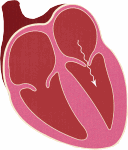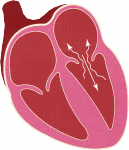Pulmonary Valve:
This regulates flow from the right ventricle to the lung circulation (pulmonary arteries). Narrowing of this valve (Pulmonary Stenosis) is uncommon and is usually detected in childhood as a murmur. In many cases, the valve is kept under review by performing echocardiograms every year or two. If necessary it can be treated with a balloon stretching device to open the valve. Leakage of the valve (Pulmonary Regurgitation) is more common, but usually reflects pressure or volume increases further on in either the lung circulation or the left side of the heart.
Mitral Valve:
Abnormalities affecting this valve which regulates flow between the left atrium and the left ventricle are quite extensive and well beyond the scope of this website!
 Mitral Stenosis: Mitral Stenosis:
This occurs when the valve becomes thickened and stuck together. It is much less common nowadays and mostly seen in immigrant groups from Asia and Africa. In the UK residual cases are sometimes seen in the elderly population. Most commonly it was attributed to childhood exposure to rheumatic fever, which resulted in “gumming up” of the valve over subsequent decades. Clinical effects may vary according to severity, but back pressure into the lungs causes breathlessness, and swelling in the legs. Stretching of the atrium can also occur causing palpitations and arrhythmia. Treatment of mitral stenosis is based on treating the arrhythmias that can co exist and preventing the risk of stroke. For more significant stenosis, either a balloon stretching operation (mitral valvuloplasty) which can be done without opening the chest, or by replacing the valve by open heart surgery.
Mitral Regurgitation (MR):
This is quite a common condition and can occur due many causes. The valve may be naturally floppy and begin to leak over time (so called “Floppy Mitral Valve”). Or the valve can “prolapse” back on its hinge causing an imperfect seal, causing a progressive leak. Occasionally the valve may leak due the hinge support (so called mitral annulus) becoming stretched because of enlargement of the left ventricle. Sometimes the valve can leak because of damage to the valve supports due to a heart attack. Alternatively, the valve can become damaged by blood borne infection (so called endocarditis).
One particularly important cause of MR is called Marfan’s Syndrome. This is a genetic condition where the connective tissues of the body are too lax. It may affect the joints of the body causing dislocations, or the eyes, causing lens dislocations. In the heart, it may affect the valves causing mitral or aortic regurgitation. Patients are often recognisable as being “slim and gangly”, often they are dancers, and usually double jointed. Importantly, their aortas can be stretched which potentially can tear (aortic dissection). Patients will usually have their family members screened, but individually assessed serially in relation to their valves and aorta. Overall, there is a lower threshold for correcting the aorta and valves if diagnosed.

Clinical presentation: Patients are frequently asymptomatic at the time of diagnosis. Over a period of time mitral regurgitation is associated with progressive heart enlargement and breathlessness.
Investigation of mitral regurgitation: Echocardiography is the mainstay of investigation, often supplemented by more invasive echocardiography (transoesophageal echocardiography). Other tests may be performed to determine the mechanism, such as coronary angiography.
Treatment of mitral regurgitation: Treatment these days is focussed at an earlier stage, preferably before the patient becomes breathless or the heart enlarges. Although medication may help with breathlessness, surgical treatment either by repairing the valve or replacing it is the more definitive treatment. In many patients, the patient can be medically managed by serial review, before surgery becomes indicated. Traditionally the chest is usually opened (thoracotomy), but the difficulty is that patients take a long time to recover. Although patients usually only spend 5-7 days on average in hospital, the recovery time after discharge can be in the order of 1-3 months before they are back to normal. In elderly patients or those with other medical conditions (especially severe lung disease) the risks of thoracotomy need to be considered. As a result, less invasive procedures can be undertaken, such as “minimally invasive surgery” or the “Mitral Clip”. The best treatment strategy is usually discussed in a multi-disciplinary team to weigh up risks and benefits.
Aortic Stenosis: The aortic valve is the last valve in the heart and regulates flow from the left ventricle into the aorta. Narrowing of this valve is not uncommon. Previously, in previous generations it was mainly due to rheumatic fever in childhood causing progressive “gumming up” of the valve leaflets, eventually restricting flow. More recently, there is a view that progressive gumming up can occur due to deposition of cholesterol between the leaflets.
There is a type due to a defective valve with two cusps instead of three (so called Bicuspid aortic valve BAV). It is important as it may be genetic, and may be associated with the aorta also being dilated (aortic aneurysm), and occasionally a narrowing of the aorta further on called coarctation (see later). In BAV patients, it is important to screen family relatives for the condition with an echocardiogram. By the same token, the aorta needs to be scanned to exclude an aortic aneurysm.
Clinical presentation of aortic stenosis:Although it can be an incidental finding (ie. a murmur is heard when examining the chest), presentation in younger patients may include dizziness on exertion, collapse, or chest pain. In people who collapse on the sports field, this condition needs to be considered. In older patients, breathlessness is a more common symptom.
Investigation and treatment of aortic stenosis: Echocardiographic assessment is the main investigation. Despite the severity of the narrowing determined by echocardiography, it is the development of any of the above symptoms that determines when the aortic valve needs surgical replacement. Indeed, surgical replacement of the valve is the definitive treatment for severe narrowing. However, patients frequently do not require surgery for many years, and just require echocardiographic assessment periodically. It is the advent of symptoms, especially breathlessness that would indicate the need for surgery. Traditional thoracotomy is usually undertaken and the patient is usually in hospital for 5-7 days, but patients take 1-3 months to fully recover. More minimally invasive surgical techniques also exist that have quicker recovery times, but this can be discussed with the surgeon.
More recently, medical replacement of the valve without open heart surgery is a valid option. It is called Trans-catheter Aortic Valve Intervention (TAVI). It was originally developed to treat elderly patients that were too frail to tolerate a thoracotomy. As with all new treatments, it takes many years to establish what the long-term outcomes. In the past, some types of artificial valves have not stood the test of time. On is keen to avoid having to re-do valve surgery as there is a mildly increased risk of complications. However, we now have a decade at least of experience of satisfactory outcomes with TAVI. In fact, it is no longer just high risk patients that are being put forward for this less invasive procedure, as the benefits have now been demonstrated for younger patients.
Aortic Regurgitation:
This is when the last valve before blood is pumped from the left ventricle into the aorta starts to leak. A variety of causes exist, but it usually occurs as a result of the aorta dilating due to weakness in the wall of the vessel.This can occur especially in genetic conditions where the body’s connective tissues such as Marfan’s Syndrome. If the valve becomes stretched, distorted (as in bicuspid aortic valve) or damaged from infection (endocarditis), the valve can leak. For asymptomatic patients, the valve and aorta are monitored over a period of time.
Clinical Presentation and Treatment of aortic regurgitation: In asymptomatic patients, if the heart or aorta enlarges on echocardiography, or the leak of the valve progresses, then surgical replacement is indicated. If patients develop breathlessness, then surgical replacement of the valve becomes necessary.
|